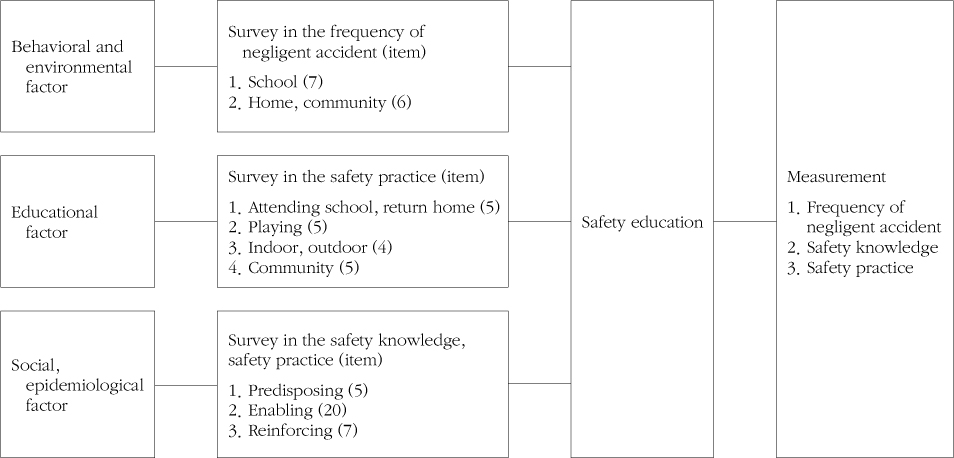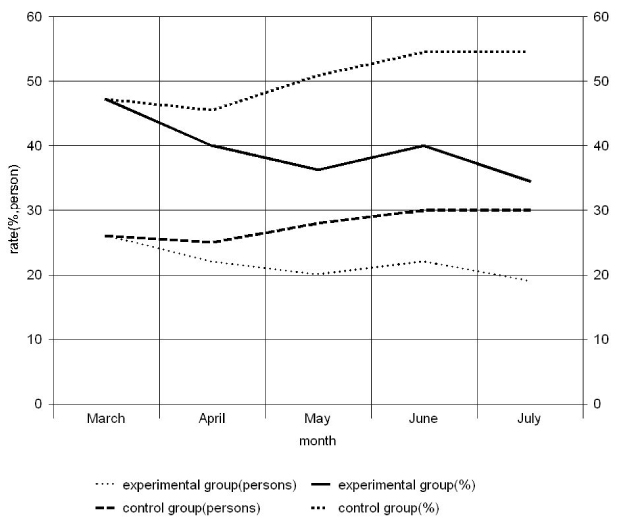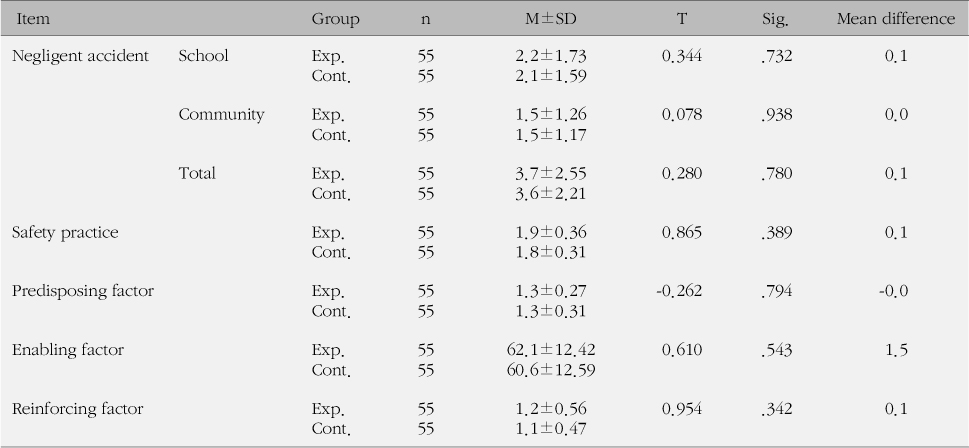Articles
- Page Path
- HOME > J Korean Acad Community Health Nurs > Volume 21(4); 2010 > Article
-
Original Article
- The Effects of a School Safety Education Program Based on the PRECEDE-PROCEED Model in Upper Grade Elementary Students
- Chung Nam Kim, En Young Lee
-
Journal of Korean Academy of Community Health Nursing 2014;21(4):419-428.
DOI: https://doi.org/10.12799/jkachn.2010.21.4.419
Published online: April 4, 2014
1Professor, Department of Nursing, Kemyung University, Korea.
2School Health Teacher, Taejeon Elementary School, Korea.
• Received: September 3, 2010 • Revised: December 1, 2010 • Accepted: December 2, 2010
© 2010 Korean Academy of Community Health Nursing
This is an Open Access article distributed under the terms of the Creative Commons Attribution Non-Commercial License (http://creativecommons.org/licenses/by-nc/3.0/) which permits unrestricted non-commercial use, distribution, and reproduction in any medium, provided the original work is properly cited.
- 657 Views
- 8 Download
- 2 Crossref
Abstract
-
Purpose
- The purpose of this study was to measure the effects of a school safety education program based on the PRECEDE-PROCEED model for upper grade elementary students.
-
Methods
- One hundred ten 6th-grade students sampled from an elementary school in D City were divided into the education group (n=55) and the non-education group (n=55). School safety education was provided to the education group for 8 weeks and a questionnaire survey about safety knowledge, safety practice and the frequency of safety negligence was carried out before and after the education from March 2 to July 13, 2010.
-
Results
- After the application of the safety education program, the education group got a higher safety knowledge score than the non-education group (p<.001). Both the education and non-education groups showed a significantly increased safety practice score (p<.01). In the comparison of safety negligence, the education group showed lower frequency (p<.01). In addition, according to the results of ANCOVA and t-test, the school safety education program influenced safety knowledge significantly (p<.001).
-
Conclusion
- This result shows that a school safety education program based on PRECEDE-PROCEED can improve safety knowledge. Further studies will be required to develop continuous and systematic safety education programs.
-
This work was supported by the Kemyung University Dongsan Medical Center Research Grant of 2007.
NOTES
- 1. Back KW, Lee MS. A diagnostic study of safety education in elementary schools based on PRECEDE model. Health Educ Promot. 2001;18(1):35–47.
- 2. Choi JH. The survey of child accident. Seoul: Korean Consumer Agency; 2009.
- 3. Chun CO. The study of school negliance in elimentary school. Chungwon: Korea National University of Education; 1997. Unpublished master's thesis.
- 4. Green LW, Kreuter MW, Deeds SG, Patridge KB. Health education planning: A diagnostic approach. California: Mountain View; 1980.
- 5. Guyer B, Gallagher SS, Chang BH, Azzara CV, Cupple LA, Colton T. Prevention of child injuries: Evaluation of the statewide childhood injury prevention program (SCIPP). Am J Public Health. 1989;79(11):1521–1527. ArticlePubMedPMC
- 6. Hayes DM, Fors SW. Self-esteem and health instruction: Challenge for curriculumn development. J Sch Health. 1990;60(5):208–211.
- 7. Huh SK, Jang SK, Noh BS. The practice of industrial safety. Seoul: Hakmoon Company; 2002.
- 8. Jun ST. A study on the safety education of elementary school. Kyungnam: Kyungnam University; 1998. Unpublished master's thesis.
- 9. Jung MA. The effect of safety education on safety knowledge and behavior among elementary school student. Taegu: Kyungpook National University; 2004. Unpublished doctoral dissertation.
- 10. Kim JU, Park BS, Kim KC, Suh JY, Yi SH, Park CW, et al. Physical education. Seoul: Kyohak Publishing; 2010.
- 11. Kim SH. A prediction model of health promotion behavior for school children. Seoul: Ewha Womans University; 2007. Unpublished doctorial dissertation.
- 12. Korea Consumer Agency. The survey of safety negligent to educational institution 2009;Retrieved May 8, 2009. from http://www.kca.go.kr
- 13. Kwang HS. A study on the pedestrian safety education for elementary school children. J Korean Soc Health Educ. 1993;10(1):61–71.
- 14. Kwon SH. Development and effect of safety education program for higher grade students of elementary school. Seoul: Yonsei University; 2005. Unpublished master's thesis.
- 15. Lee EY. The effect of safety education on safety knowledge and behavior among elementary school student. Daegu: Kyungpook National University; 2001. Unpublished master's thesis.
- 16. Lee KY. The effect of theoretical and practical reinforced instruction of traffic safety on elementary student's traffic safety rule behavior. Jeonju: Chonbuk National University; 2005. Unpublished master's thesis.
- 17. Loescher LJ, Taylor A, Christensen DH, Mckinney M. Educating preschoolers about sun safety. Am J Public Health. 1995;85(7):939–943. ArticlePubMedPMC
- 18. Ministry of Education, Science, Technology Official Announcement. Repaired curriculum in the health education 2008;09 12 Retrieved September 12, 2008. from http://www.mest.go.kr
- 19. Newsis. The frequency of school negligency & pay a bounty during past 3 years 2010;09 26 Retrieved September 26, 2010. from http://www.newsis.com/ar_detail/view.html?ar_id=NISX20100926_0006259509&cID=10201&pID=10200
- 20. Renaud L, Suissa S. Evaluation of the efficacy of simulation games in traffic safety education of kindergarten children. Am J Public Health. 1989;79(3):307–309. ArticlePubMedPMC
- 21. Sim MY, No HY, Cho SS, Cho YJ, Choi MS, Shin HJ, et al. Health. Daegu: Sukyung Publishing; 2009.
- 22. Son JH. The study on the effectiveness of participatory road traffic safety education for the elementary school student in Korea. Seoul: Ewha Womans University; 2006. Unpublished master's thesis.
- 23. Statistics Korea. 2007 Social survey in education, safety, environment 2008;Retrieved October 21, 2008. from http://kostat.go.kr/wnsearchNew/search.jsp
- 24. Yoon SY, Lee KS, Lee HJ, Shin YM, Kim CM, Choi JM. Health promotion. Seoul: Soomoon Publishing; 2000.
Figure & Data
References
Citations
Citations to this article as recorded by 

- Effect of the PRECEDE-PROCEED model on health programs: a systematic review and meta-analysis
Junghee Kim, Jaeun Jang, Bora Kim, Kyung Hee Lee
Systematic Reviews.2022;[Epub] CrossRef - Case Study the Awareness of Safety Education and School Safety of one Technical high school Students
Young Ho Hong
Journal of the Korea Academia-Industrial cooperation Society.2016; 17(7): 536. CrossRef

 KACHN
KACHN








 PubReader
PubReader Cite
Cite




